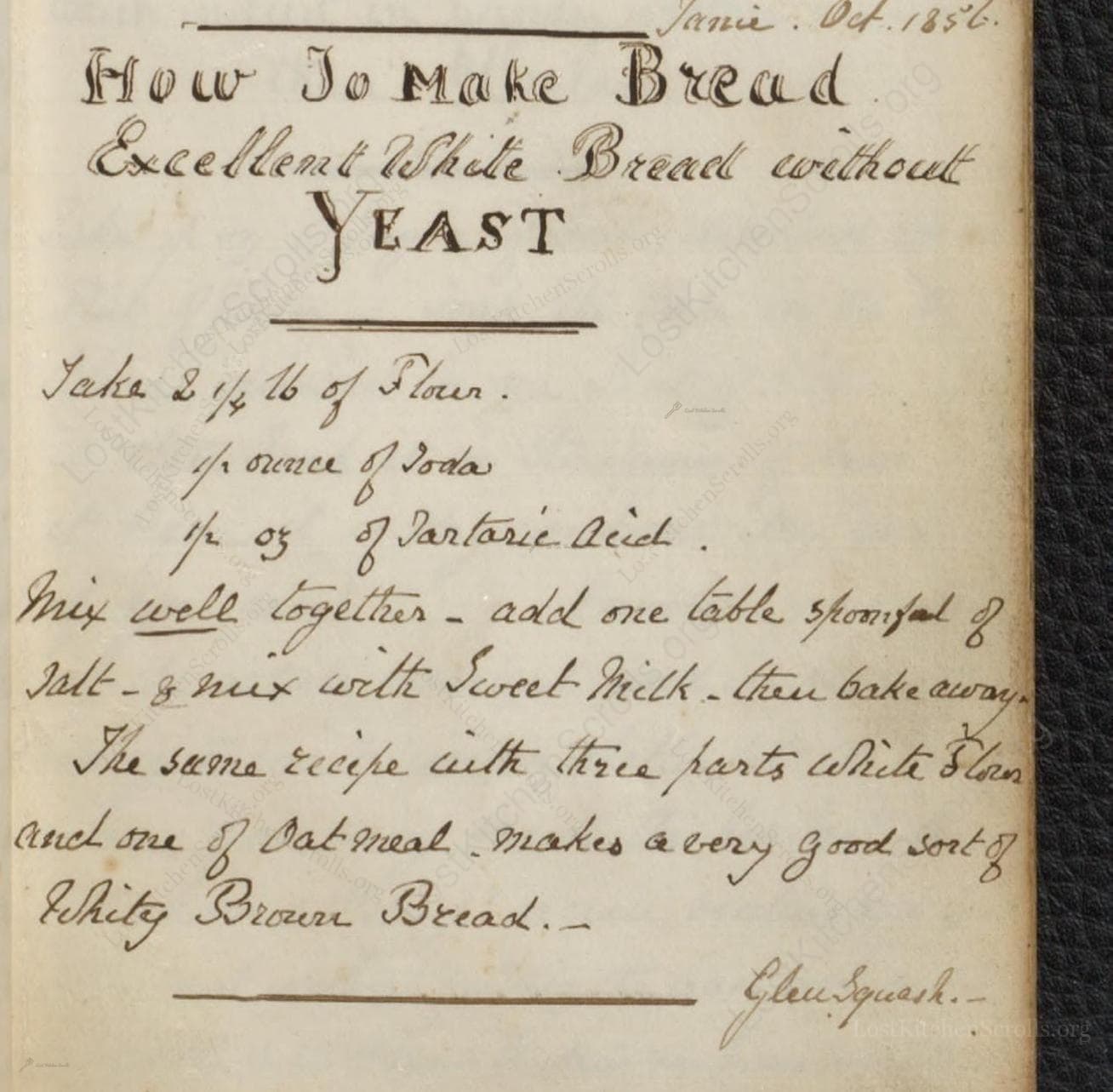
How To Make Bread Excellent White Bread Without Yeast
"How To Make Bread. Excellent White Bread without YEAST Take 2 1/4 lb of Flour. 1/2 ounce of Soda 1/2 oz of Tartaric Acid. Mix well together - add one table spoonful of Salt - & mix with Sweet Milk - then bake away. The same recipe with three parts White Flour and one of Oatmeal - makes a very good sort of Whity Brown Bread. - GlenSquash.-"
Note on the Original Text
The recipe is short and direct, typical of 19th-century manuscript style where brevity and prior cooking knowledge were assumed. Ingredients are listed in imperial weights, and chemical leaveners are called by their period names—'soda' for baking soda, 'tartaric acid' rather than cream of tartar. Directions are minimal: 'bake away' sums up the process with a wink, expecting the reader to know what a bread dough should feel like and how long to bake it. Spelling and punctuation are irregular, reflecting informal, handwritten note-taking rather than published print style. The phrase 'Sweet milk' simply means whole fresh milk, as opposed to buttermilk.

Title
Recipe book of Charles Ellice, Colonel, 24th Regiment (1856)
You can also click the book image above to peruse the original tome
Writer
Charles Ellice, Colonel
Era
1856
Publisher
Colonel Charles Ellice
Background
A charming manuscript cookbook chronicling the culinary escapades of Colonel Charles Ellice during his globe-trotting military career, featuring recipes from Highland butter to yeastless bread, spicy curries, and even a dash of Victorian medicine—all penned alongside evocative ink sketches and a personal index.
Kindly made available by
McGill University
This recipe originates from a 19th-century manuscript by Colonel Charles Ellice, an officer of the 24th Regiment, whose personal cookbook reflected both Highland traditions and the practical needs of travel and posting, notably in colonial India. In the absence of reliable or fresh yeast, chemical leavening offered a quick and practical bread for officers and their households, suitable for remote postings or field kitchens. The inclusion of ink drawings of Highland scenes reveals the nostalgic connection to Scottish foodways, and this bread would have evoked the comfort and resilience of home, offering sustenance far from familiar landscapes.

Historically, mixing would be done in a large earthenware or wooden bowl with a sturdy wooden spoon. The dough might be shaped by hand on a wooden board. Baking would take place in a cast iron oven, brick bread oven, or even an open camp oven over hot coals, using thick iron or tin bread pans if available. No stand mixers, measuring jugs, or calibrated ovens—just the cook’s practiced hand, a sturdy hearth, and a keen eye for doneness.
Prep Time
15 mins
Cook Time
40 mins
Servings
16
We've done our best to adapt this historical recipe for modern kitchens, but some details may still need refinement. We warmly welcome feedback from fellow cooks and culinary historians — your insights support the entire community!
Ingredients
- 2 lb 3 oz (35 oz) plain (all-purpose) flour
- 0.53 oz (1 tablespoon) baking soda (sodium bicarbonate)
- 0.53 oz (1 tablespoon) tartaric acid (as alternative: cream of tartar or citric acid in equal measure)
- 0.53 oz (1 tablespoon) salt
- 2 3/4 to 3 cups whole (sweet) milk
- Optional: 8.8 oz oat flour (for variation, replacing part of white flour)
Instructions
- To prepare this historical white bread without yeast, begin by thoroughly mixing 2 lb 3 oz (35 oz) of plain (all-purpose) flour with 0.53 oz (1 tablespoon) of baking soda (sodium bicarbonate) and 0.53 oz (1 tablespoon) of tartaric acid.
- Add 1 tablespoon (about 0.53 oz) of salt and stir to combine.
- Pour in enough fresh whole milk—approximately 2 3/4 to 3 cups—to make a soft but not sticky dough.
- Once combined, knead gently, shape into a loaf or divide into rolls, and bake immediately in a preheated oven at 392°F until golden brown and baked through (about 30-40 minutes for a loaf, 15-20 minutes for rolls).
- To make a 'Whity Brown Bread,' use 1 lb 10 oz (26 oz) of white flour and 8.8 oz of oat flour (or finely ground rolled oats) with the same proportions for the other ingredients.
Estimated Calories
140 per serving
Cooking Estimates
It usually takes about 10-15 minutes to mix and knead the dough, then about 30-40 minutes to bake a loaf of this bread. Each serving is based on an average slice if you cut the baked loaf into 16 pieces. Each serving contains around 140 calories.
As noted above, we have made our best effort to translate and adapt this historical recipe for modern kitchens, taking into account ingredients nowadays, cooking techniques, measurements, and so on. However, historical recipes often contain assumptions that require interpretation.
We'd love for anyone to help improve these adaptations. Community contributions are highly welcome. If you have suggestions, corrections, or cooking tips based on your experience with this recipe, please share them below.
Join the Discussion
Rate This Recipe

Den Bockfisch In Einer Fleisch Suppen Zu Kochen
This recipe hails from a German manuscript cookbook compiled in 1696, a time whe...

Die Grieß Nudlen Zumachen
This recipe comes from a rather mysterious manuscript cookbook, penned anonymous...

Ein Boudain
This recipe comes from an anonymous German-language manuscript cookbook from 169...

Ein Gesaltzen Citroni
This recipe, dating from 1696, comes from an extensive anonymous German cookbook...
Browse our complete collection of time-honored recipes



